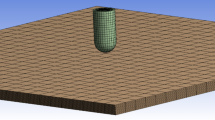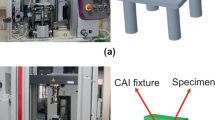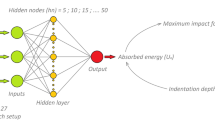Abstract
The carbon fiber–reinforced polymer (CFRP) structure in the aviation industry is typically subject to low-velocity impact damage during the assembly process, which can have a catastrophic effect on the strength and durability of composite structures. To reduce the impact of this damage on the composite structure, a composite laminate with a rubber protective layer has been proposed and proved to be effective in reducing the low-velocity impact damage. The delamination volume of the composite laminate with a rubber layer under low-velocity impact loadings was predicted in this study using a back-propagation neural network (BPNN). Various factors were considered, which can affect the delamination damage volume including impact diameter, rubber layer thickness, impact velocity, and specimen area. To generate enough training data, hundreds of finite element models have been simulated with various factors mentioned above as input data. Low-velocity impact tests have been conducted to validate simulation results. Simulation results were processed into delamination volume by python as output data, which can describe the damage degree of the composite. These input and output data were trained by a back-propagation network until the learning results meet the expected accuracy. The prediction error with simulation results and experiment results were within 4.3% and 11.2%, respectively.
















Similar content being viewed by others
Data availability
All data generated or mentioned during this study are included in this published article.
Code availability
No code was provided in this manuscript.
References
Liang B, Bossie P (2021) A review of numerical analyses and experimental characterization methods for forming of textile reinforcements. Chin J Aeronaut 34(8):143–163. https://doi.org/10.1016/j.cja.2020.09.027
Tuo H, Lu Z, Ma X, Zhang C, Chen SW (2019) An experimental and numerical investigation on low velocity impact damage and compression-after-impact behavior of composite laminates. Compos B Eng 167:329–341. https://doi.org/10.1016/j.compositesb.2018.12.043
Morada G, Ouadday R, Vadean A, Boukhili R (2017) Low velocity impact resistance of ATH/epoxy core sandwich composite panels: experimental and numerical analyses. Compos B Eng 114:418–431. https://doi.org/10.1016/j.compositesb.2017.01.070
Zhang XY, Xu F, Zang YY, Feng W (2020) Experimental and numerical investigation on damage behavior of honeycomb sandwich panel subjected to low velocity impact. Compos Struct 236:111882. https://doi.org/10.1016/j.compstruct.2020.111882
Andrew JJ, Srinivasan SM, Arockiarajan A (2019) Influence of patch lay-up configuration and hybridization on low velocity impact and post-impact tensile response of repaired glass fiber rein-forced plastic composites. J Compos Mater 53:3–17. https://doi.org/10.1177/0021998318779430
Düring D, Weiß L, Stefaniak D, Jordan N, Huhne C (2015) Low velocity impact response of composite laminates with steel and elastomer protective layer. Compos Struct 134:18–26. https://doi.org/10.1016/j.compstruct.2015.08.001
Li XM, Liang B, Liu P, Cheng H, Cao SP, Zhang KF (2022) Experimental and numerical analysis of low-velocity impact damage of CFRP laminates with rubber protective layer. Compos Struct 300:116152. https://doi.org/10.1016/j.compstruct.2022.116152
Düring D, Petersen E, Stefaniak D, Huhne C (2020) Damage resistance and low velocity impact behaviour of hybrid composite laminates with multiple thin steel and elastomer layers. Compos Struct 238:111851. https://doi.org/10.1016/j.compstruct.2019.111851
López Puente J, Zaera R, Navarro C (2002) The effect of low temperatures on the intermediate and high velocity impact response of CFRPs. Compos Part B: Eng 33:559–566. https://doi.org/10.1016/S1359-8368(02)00065-3
Will M, Franz T, Nurick G (2002) The effect of laminate stacking sequence of cfrp filament wound tubes subjected to projectile impact. Compos Struct 58:259–270. https://doi.org/10.1016/S0263-8223(02)00050-8
Hosur M, Vaidya U, Ulven C, Jeelani S (2004) Performance of stitched/unstitched woven carbon/epoxy composites under high velocity impact loading. Compos Struct 64:455–466. https://doi.org/10.1016/j.compstruct.2003.09.046
Hari PPD, Anthony R, Guneet KM, Fayazbakhsh K (2020) Experimental characterization of 3D printed thermoplastic plates subjected to low velocity impact. INT J ADV MANUF TECH 107:1659–1669. https://doi.org/10.1007/s00170-020-05120-4
Duan Y, Keefe M, Bogetti T, Cheeseman BA (2005) Modeling the role of friction during ballistic impact of a high-strength plain-weave fabric. Compos Struct 68:331–337. https://doi.org/10.1016/j.compstruct.2004.03.026
Chan S, Fawaz Z, Behdinan AR (2007) Ballistic limit prediction using a numerical model with progressive damage capability. Compos Struct 77:466–474. https://doi.org/10.1016/j.compstruct.2005.08.022
Fernández D, López Puente J, Zaera R (2008) Prediction of the behaviour of CFRPs against high-velocity impact of solids employing an artificial neural network methodology. Compos Part A-APPL S 39:989–996. https://doi.org/10.1016/j.compositesa.2008.03.002
Xu Y, Liu G, Wu Z, Huang XM (2001) Adaptive multilayer perceptron networks for detection of cracks in anisotropic laminated plates. Int J Solids Struct 38:5625–5645. https://doi.org/10.1016/S0020-7683(00)00368-1
Just Agosto F, Serrano D, Cecchini SBA (2008) Neural network based nondestructive evaluation of sandwich composites. Compos Part B: Eng 39(1):217–325. https://doi.org/10.1016/j.compositesb.2007.02.023
Kesavan A, Deivasigamani M, John S, Li H, Herszberg I (2006) Damage detection in t-joint composite structures. Compos Struct 75:313–320. https://doi.org/10.1016/j.compstruct.2006.04.047
Yam L, Yan Y, Jiang J (2003) Vibration-based damage detection for composite structures using wavelet transform and neural network identification. Compos Struct 60:403–412. https://doi.org/10.1016/S0263-8223(03)00023-0
Seo D, Lee J (1999) Damage detection of cfrp laminates using electrical resistance measurement and neural network. Compos Struct 47(1-4):525–530. https://doi.org/10.1016/S0263-8223(00)00016-7
Agrawal A, Choudhary A (2016) Perspective: materials informatics and big data: realization of the fourth paradigm of science in materials science. APL Mater 4(5):053208. https://doi.org/10.1063/1.4946894
El Kadi H (2016) Modeling the mechanical behavior of fiber-reinforced polymeric composite materials using artificial neural networks—a review. Compos Struct 73:1–23. https://doi.org/10.1016/j.compstruct.2005.01.020
Fan H, Wang H (2014) Predicting the open-hole tensile strength of composite plates based on probabilistic neural network. Appl Compos Mater 21:827–840. https://doi.org/10.1007/s10443-014-9387-2
Altabey WA, Noori M (2017) Fatigue life prediction for carbon fibre/epoxy laminate composites under spectrum loading using two different neural network architectures. International Journal of Sustainable Materials and Structural Systems 3:53–78. https://doi.org/10.1504/IJSMSS.2017.092252
Balokas G, Czichon S, Rolfes R (2018) Neural network assisted multiscale analysis for the elastic properties prediction of 3D braided composites under uncertainty. Compos Struct 183:550–562. https://doi.org/10.1016/j.compstruct.2017.06.037
Vineela MG, Dave A, Chaganti PK (2018) Artificial neural network based prediction of tensile strength of hybrid composites. Materials Today: Proceedings 5:19908–19915. https://doi.org/10.1016/j.matpr.2018.06.356
Chen G, Wang H, Bezold A (2019) Strengths prediction of particulate reinforced metal matrix composites (PRMMCs) using direct method and artificial neural network. Compos Struct 223:110951. https://doi.org/10.1016/j.compstruct.2019.110934
Chandrashekhara K, Okafor A, Jiang Y (1998) Estimation of contact force on composite plates using impact-induced strain and neural networks. Compos Part B: Eng 29:363–370. https://doi.org/10.1117/12.240871
Fernández Fdz D, Zaera R (2008) A new tool based on artificial neural networks for the design of lightweight ceramic-metal armors against high-velocity impact of solids. Int J Solids Struct. https://doi.org/10.1016/j.ijsolstr.2008.08.009
Haykin S (1999) Neural networks: a comprehensive foundation, 2nd edn, Prentice Hall, NJ
Hertz J, Krogh A, Palmer RG (1998) Introduction to the theory of neural computation. Phys Today 44:70. https://doi.org/10.1145/230514.571645
Wu TY, Lei KW (2019) Correction to: Prediction of surface roughness in milling process using vibration signal analysis and artificial neural network. Int J Adv Manuf Technol 102:315. https://doi.org/10.1007/s00170-019-03317-w
Funding
This work was supported by the Key Research on High-Performance Manufacturing (No. 2022YFB3404100) and Ping Liu is in charge of this project. And this study was also funded by the National Natural Science Foundation of China (No. 52275512), and Yuan Li is in charge of this project.
Author information
Authors and Affiliations
Contributions
All the authors contributed to the study conception and design. The theoretical method is proposed by Ximing Li and Ping Liu. The first draft of the manuscript was written by Ximing Li. The experimental site and simulation were provided by Yuan Li and Hui Cheng. The back-propagation neural networks were conducted by Kaifu Zhang and Chinan Liu. All the authors commented on previous versions of the manuscript. All the authors read and approved the final manuscript.
Corresponding author
Ethics declarations
Ethical approval
This study does not involve ethical issues.
Consent to participate
The study is not a study of life science, so the “consent to participate” does not apply.
Consent to publication
All the authors have reviewed the final version of the manuscript and approve it for publication. We claim that none of the material in the paper has been published or is under consideration for publication elsewhere.
Competing interests
The authors declare no competing interests.
Additional information
Publisher’s note
Springer Nature remains neutral with regard to jurisdictional claims in published maps and institutional affiliations.
Rights and permissions
Springer Nature or its licensor (e.g. a society or other partner) holds exclusive rights to this article under a publishing agreement with the author(s) or other rightsholder(s); author self-archiving of the accepted manuscript version of this article is solely governed by the terms of such publishing agreement and applicable law.
About this article
Cite this article
Li, X., Liu, P., Cheng, H. et al. Impact damage prediction of CFRP laminates with rubber protective layer using back-propagation neural networks. Int J Adv Manuf Technol 127, 3281–3296 (2023). https://doi.org/10.1007/s00170-023-11647-z
Received:
Accepted:
Published:
Issue Date:
DOI: https://doi.org/10.1007/s00170-023-11647-z




